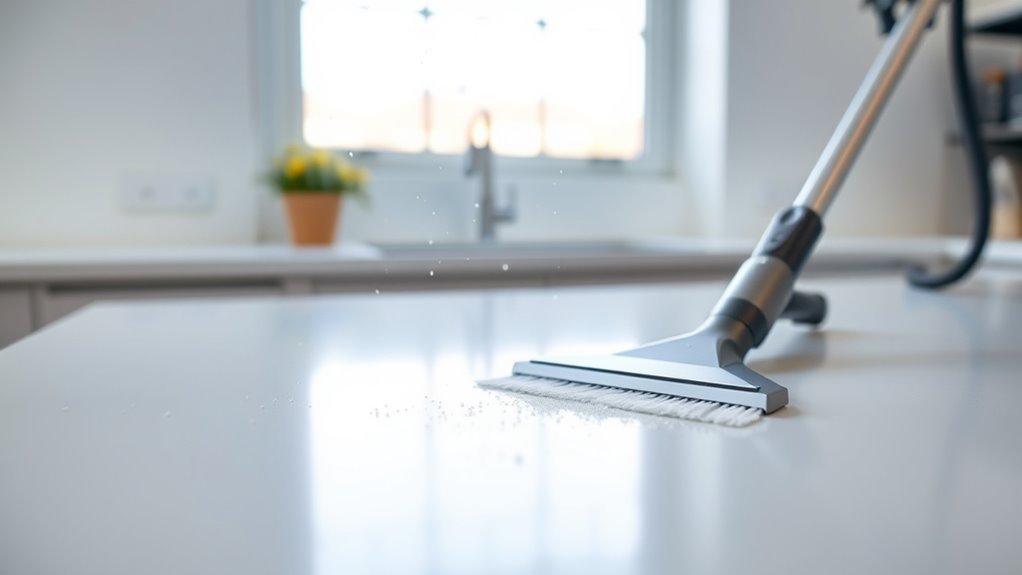To make dust vanish for weeks, use a HEPA air purifier regularly in high-traffic areas, and keep HVAC filters upgraded to trap smaller particles. Maintain a strict cleaning routine by wiping surfaces with microfiber cloths, washing curtains, and vacuuming with HEPA equipment. Keep clutter to a minimum and enforce a no-shoes policy to prevent dirt from entering. Consistent ventilation and proper home maintenance boost long-lasting cleanliness—discover more tips within to extend your dust-free zone even further.
Key Takeaways
- Use a high-quality HEPA air purifier continuously in high-traffic and dust-prone areas.
- Maintain proper ventilation by regularly changing HVAC filters with high MERV ratings and opening windows.
- Keep surfaces clutter-free, wash textiles frequently, and vacuum with HEPA-equipped cleaners to reduce dust reservoirs.
- Establish a consistent cleaning routine, including top-to-bottom dusting and damp wiping to prevent dust buildup.
- Enforce a no-shoes policy and mop floors regularly to minimize tracked-in dirt and dust settling on surfaces.

Have you ever wondered how to make dust vanish effortlessly? Dust can be relentless, settling quickly and making your space look grimy even after cleaning. The secret isn’t just about wiping it away but about creating an environment where dust has fewer places to settle and doesn’t cling as stubbornly. To make dust disappear for weeks, you need to focus on reducing its sources and improving your cleaning routine. Start by tackling the air quality in your home. Dust particles float around and settle on surfaces, so using a high-efficiency particulate air (HEPA) purifier can dramatically cut down airborne dust. Keep it running regularly, especially in rooms where you spend most of your time. This device captures tiny particles before they settle, considerably reducing dust accumulation over time.
Using a HEPA purifier helps keep airborne dust at bay and maintains a cleaner home longer.
Next, pay attention to your ventilation. Proper airflow helps prevent dust from stagnating. Regularly change your HVAC filters to make sure they trap dust effectively. Opt for filters with a higher MERV rating, which can catch smaller particles that standard filters might miss. Additionally, guarantee your home is well-ventilated by opening windows whenever possible. This exchange of air discourages dust buildup and keeps indoor air fresh. Remember, dust isn’t just on surfaces; it’s also in the fibers of your furniture, curtains, and bedding. Regularly washing your curtains, vacuuming upholstery with a HEPA-equipped cleaner, and changing bedding frequently can prevent dust from hiding in these spots.
Another vital step is minimizing clutter. Dust loves to settle on surfaces piled high with books, papers, and decorative items. By decluttering regularly, you reduce the number of surfaces where dust can collect and make cleaning easier. When you do clean, dust from top to bottom, starting with high shelves and working your way down. Use microfiber cloths that trap dust instead of just spreading it around. Wet-dusting can also help pick up more particles than dry dusting. Be diligent with your cleaning schedule—what seems like a quick wipe today can save you from daily dust accumulation tomorrow. Remember, consistency is key to maintaining a dust-free environment for longer periods.
Finally, consider your footwear habits. Shoes track in dirt and dust from outside, bringing it into your home. Establish a no-shoes policy at the door or keep a designated area for shoes to prevent unnecessary dirt from settling in. Regularly mopping floors with a damp mop helps pick up dust that has settled on surfaces and floors. When you combine these steps—air purification, proper ventilation, decluttering, thorough cleaning, and footwear management—you create a home environment where dust doesn’t stand a chance to settle quickly or stubbornly. This proactive approach means your space stays cleaner-looking for weeks, making dust less of a constant chore and more of a fleeting nuisance. Incorporating high-quality filtration systems can further optimize your efforts and keep dust at bay for longer periods.
Frequently Asked Questions
Can Air Purifiers Completely Eliminate Dust?
Air purifiers can substantially reduce dust in your home, but they can’t completely eliminate it. They work by trapping airborne particles, including dust mites and pollen, improving air quality. However, dust settles on surfaces and re-enters the air constantly. To keep dust levels low, you should regularly clean, vacuum with HEPA filters, and maintain good ventilation alongside using an air purifier. This combined approach offers the best results.
How Often Should I Deep Clean My Home to Prevent Dust Buildup?
Think of your home as a garden that needs regular tending. You should deep clean at least once a month to keep dust at bay. Focus on vacuuming carpets, dusting surfaces, and cleaning vents thoroughly. Regular deep cleaning prevents dust from taking root and spreading. If you have pets or allergies, consider more frequent sessions. Staying proactive keeps your space fresh and dust-free, making your home a healthier haven.
Are There Natural Remedies to Reduce Dust Levels?
Yes, you can use natural remedies to reduce dust levels. Regularly dust with a damp cloth to trap particles, and sprinkle baking soda on carpets before vacuuming to absorb dust and odors. Adding houseplants like spider plants or peace lilies can improve air quality by filtering airborne dust. Also, use natural air purifiers like activated charcoal or essential oils such as eucalyptus to help keep dust at bay naturally.
What Are the Best Tools for Dust Removal?
You should use a microfiber cloth or duster to trap dust effectively. A HEPA vacuum cleaner is excellent for removing dust from carpets, upholstery, and hard-to-reach areas. An air purifier with a HEPA filter helps improve air quality by capturing airborne dust particles. Additionally, using a damp cloth on surfaces prevents dust from becoming airborne again. Regularly employing these tools keeps your space cleaner and dust-free longer.
Does Humidity Control Help Reduce Dust Accumulation?
Humidity control can markedly reduce dust accumulation, as studies show maintaining indoor humidity levels between 40-50% can cut dust particles by up to 60%. When you keep the air moist, dust clumps together and settles faster, reducing airborne particles. You should use a humidifier or dehumidifier as needed, especially in dry seasons. This simple step not only minimizes dust but also improves your overall indoor air quality.
Conclusion
Now that you know how to keep dust at bay for weeks, isn’t it worth the extra effort? Regular cleaning, air purifiers, and proper ventilation can transform your space into a dust-free haven. Don’t settle for fleeting cleanliness—embrace these habits and enjoy a fresher, healthier home. After all, isn’t life too short to spend it constantly battling dust? Start today, and let your home breathe cleaner, longer.









